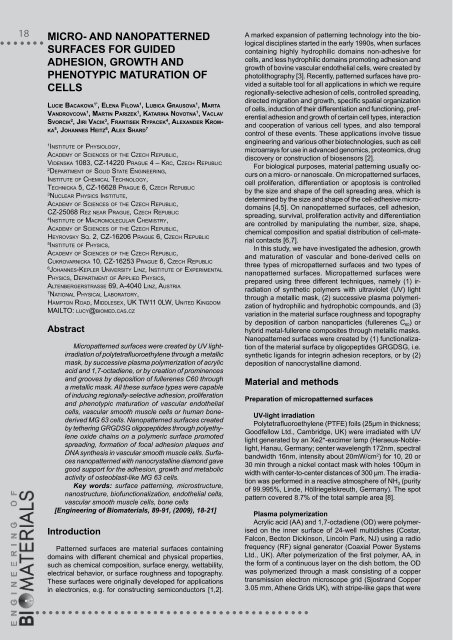89-91 - Polskie Stowarzyszenie Biomateriałów
89-91 - Polskie Stowarzyszenie Biomateriałów
89-91 - Polskie Stowarzyszenie Biomateriałów
Create successful ePaper yourself
Turn your PDF publications into a flip-book with our unique Google optimized e-Paper software.
mICRo- and nanoPaTTERnEd<br />
SuRfaCES foR guIdEd<br />
adhESIon, gRoWTh and<br />
PhEnoTyPIC maTuRaTIon of<br />
CEllS<br />
LUCIE BACAKOVA 1* , ELENA FILOVA 1 , LUBICA GRAUSOVA 1 , MARTA<br />
VANDROVCOVA 1 , MARTIN PARIZEK 1 , KATARINA NOVOTNA 1 , VACLAV<br />
SVORCIK 2 , JIRI VACIK 3 , FRANTISEK RYPACEK 4 , ALEXANDER KROM-<br />
KA 5 , JOHANNES HEITZ 6 , ALEX SHARD 7<br />
1 inStitute oF PhySioloGy,<br />
AcAdeMy oF ScienceS oF the czech rePublic,<br />
VidenSKA 1083, cz-14220 PrAGue 4 – Krc, czech rePublic<br />
2 dePArtMent oF Solid StAte enGineerinG,<br />
inStitute oF cheMicAl technoloGy,<br />
technicKA 5, cz-16628 PrAGue 6, czech rePublic<br />
3nucleAr PhySicS inStitute,<br />
AcAdeMy oF ScienceS oF the czech rePublic,<br />
cz-25068 rez neAr PrAGue, czech rePublic<br />
4inStitute oF MAcroMoleculAr cheMiStry,<br />
AcAdeMy oF ScienceS oF the czech rePublic,<br />
heyroVSKy Sq. 2, cz-16206 PrAGue 6, czech rePublic<br />
5inStitute oF PhySicS,<br />
AcAdeMy oF ScienceS oF the czech rePublic,<br />
cuKroVArnicKA 10, cz-16253 PrAGue 6, czech rePublic<br />
6johAnneS-KePler uniVerSity linz, inStitute oF exPeriMentAl<br />
PhySicS, dePArtMent oF APPlied PhySicS,<br />
AltenberGerStrASSe 69, A-4040 linz, AuStriA<br />
7nAtionAl PhySicAl lAborAtory,<br />
hAMPton roAd, MiddleSex, uK tw11 0lw, united KinGdoM<br />
MAilto: lucy@bioMed.cAS.cz<br />
abstract<br />
Micropatterned surfaces were created by UV lightirradiation<br />
of polytetrafluoroethylene through a metallic<br />
mask, by successive plasma polymerization of acrylic<br />
acid and 1,7-octadiene, or by creation of prominences<br />
and grooves by deposition of fullerenes C60 through<br />
a metallic mask. All these surface types were capable<br />
of inducing regionally-selective adhesion, proliferation<br />
and phenotypic maturation of vascular endothelial<br />
cells, vascular smooth muscle cells or human bonederived<br />
MG 63 cells. Nanopatterned surfaces created<br />
by tethering GRGDSG oligopeptides through polyethylene<br />
oxide chains on a polymeric surface promoted<br />
spreading, formation of focal adhesion plaques and<br />
DNA synthesis in vascular smooth muscle cells. Surfaces<br />
nanopatterned with nanocrystalline diamond gave<br />
good support for the adhesion, growth and metabolic<br />
activity of osteoblast-like MG 63 cells.<br />
Key words: surface patterning, microstructure,<br />
nanostructure, biofunctionalization, endothelial cells,<br />
vascular smooth muscle cells, bone cells<br />
[Engineering of Biomaterials, <strong>89</strong>-<strong>91</strong>, (2009), 18-21]<br />
Introduction<br />
Patterned surfaces are material surfaces containing<br />
domains with different chemical and physical properties,<br />
such as chemical composition, surface energy, wettability,<br />
electrical behavior, or surface roughness and topography.<br />
These surfaces were originally developed for applications<br />
in electronics, e.g. for constructing semiconductors [1,2].<br />
A marked expansion of patterning technology into the biological<br />
disciplines started in the early 1990s, when surfaces<br />
containing highly hydrophilic domains non-adhesive for<br />
cells, and less hydrophilic domains promoting adhesion and<br />
growth of bovine vascular endothelial cells, were created by<br />
photolithography [3]. Recently, patterned surfaces have provided<br />
a suitable tool for all applications in which we require<br />
regionally-selective adhesion of cells, controlled spreading,<br />
directed migration and growth, specific spatial organization<br />
of cells, induction of their differentiation and functioning, preferential<br />
adhesion and growth of certain cell types, interaction<br />
and cooperation of various cell types, and also temporal<br />
control of these events. These applications involve tissue<br />
engineering and various other biotechnologies, such as cell<br />
microarrays for use in advanced genomics, proteomics, drug<br />
discovery or construction of biosensors [2].<br />
For biological purposes, material patterning usually occurs<br />
on a micro- or nanoscale. On micropatterned surfaces,<br />
cell proliferation, differentiation or apoptosis is controlled<br />
by the size and shape of the cell spreading area, which is<br />
determined by the size and shape of the cell-adhesive microdomains<br />
[4,5]. On nanopatterned surfaces, cell adhesion,<br />
spreading, survival, proliferation activity and differentiation<br />
are controlled by manipulating the number, size, shape,<br />
chemical composition and spatial distribution of cell-material<br />
contacts [6,7].<br />
In this study, we have investigated the adhesion, growth<br />
and maturation of vascular and bone-derived cells on<br />
three types of micropatterned surfaces and two types of<br />
nanopatterned surfaces. Micropatterned surfaces were<br />
prepared using three different techniques, namely (1) irradiation<br />
of synthetic polymers with ultraviolet (UV) light<br />
through a metallic mask, (2) successive plasma polymerization<br />
of hydrophilic and hydrophobic compounds, and (3)<br />
variation in the material surface roughness and topography<br />
by deposition of carbon nanoparticles (fullerenes C 60) or<br />
hybrid metal-fullerene composites through metallic masks.<br />
Nanopatterned surfaces were created by (1) functionalization<br />
of the material surface by oligopeptides GRGDSG, i.e.<br />
synthetic ligands for integrin adhesion receptors, or by (2)<br />
deposition of nanocrystalline diamond.<br />
material and methods<br />
Preparation of micropatterned surfaces<br />
uv-light irradiation<br />
Polytetrafluoroethylene (PTFE) foils (25µm in thickness;<br />
Goodfellow Ltd., Cambridge, UK) were irradiated with UV<br />
light generated by an Xe2*-excimer lamp (Heraeus-Noblelight,<br />
Hanau, Germany; center wavelength 172nm, spectral<br />
bandwidth 16nm, intensity about 20mW/cm 2 ) for 10, 20 or<br />
30 min through a nickel contact mask with holes 100µm in<br />
width with center-to-center distances of 300 µm. The irradiation<br />
was performed in a reactive atmosphere of NH 3 (purity<br />
of 99.995%, Linde, Höllriegelskreuth, Germany). The spot<br />
pattern covered 8.7% of the total sample area [8].<br />
Plasma polymerization<br />
Acrylic acid (AA) and 1,7-octadiene (OD) were polymerised<br />
on the inner surface of 24-well multidishes (Costar,<br />
Falcon, Becton Dickinson, Lincoln Park, NJ) using a radio<br />
frequency (RF) signal generator (Coaxial Power Systems<br />
Ltd., UK). After polymerization of the first polymer, AA, in<br />
the form of a continuous layer on the dish bottom, the OD<br />
was polymerized through a mask consisting of a copper<br />
transmission electron microscope grid (Sjostrand Copper<br />
3.05 mm, Athene Grids UK), with stripe-like gaps that were













